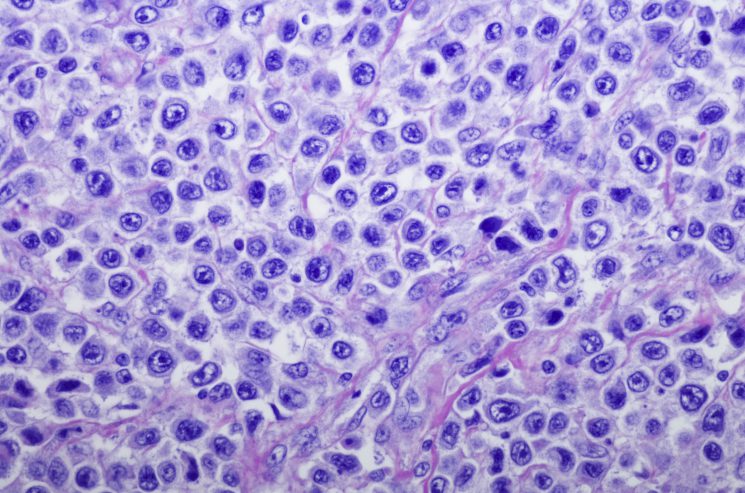The lymphatic system is a key part of the body’s immune system. Lymph nodes and vessels carry fluid, nutrients, and waste material through the body and bloodstream. Nodes trap bacteria, viruses, and other foreign materials to be destroyed by special white blood cells called lymphocytes.
Sometimes the lymphocytes can grow abnormally and become cancerous. This is known as lymphoma.
There are two types of lymphoma: Hodgkin and non-Hodgkin, and Hodgkin is the rarer of the two.
Find out more about Hodgkin lymphoma, including symptoms and treatment.
What Causes Lymphoma?
Lymphoma is one of the three major types of blood cancers, along with leukemia and myeloma. About half of blood cancer cases are lymphoma, according to the American Society of Hematology.
Abnormal growth in lymphocytes can cause lymphoma. There are two major types of lymphocytes:
- B cells, which make antibodies to help fight off bacteria, viruses, and other foreign substances
- T cells, which can serve different roles, including destroying abnormal cells or germs, or boosting or slowing other cells in your immune system
Because the lymph system can be found throughout your body, lymphoma can begin almost anywhere.
Never Miss a Beat!
Subscribe to Our HealthBeat Newsletter!
Thank you for subscribing!
You can now select the specific newsletters you'd like to receive.
You are already subscribed.
Subscribe to more newsletters in our email preference center.
Sorry, an error occurred. Please try again later.
Get Healthy Tips Sent to Your Phone!
What’s the Difference Between Hodgkin and Non-Hodgkin Lymphoma?
Hodgkin lymphoma is much rarer than non-Hodgkin lymphoma, accounting for about 12% of cases. There are about 60 different types of non-Hodgkin lymphoma. There are several differences between Hodgkin and non-Hodgkin lymphoma:
- Hodgkin lymphoma usually begins in B lymphocytes. Non-Hodgkin lymphoma can affect both B and T lymphocytes.
- Unlike non-Hodgkin lymphoma, Hodgkin lymphoma contains Reed-Sternberg cells, which are larger and may include more than one nucleus.
- Hodgkin lymphoma typically begins in the lymph nodes of the upper body, most commonly in the chest, neck, or under the arms.
- Hodgkin lymphoma more commonly affects people who are young (15 to 24 years old) or older (60 years old and above). The average age of people with non-Hodgkin lymphoma is 60 years old.
Risk Factors for Hodgkin Lymphoma
While the exact cause of Hodgkin lymphoma is unknown in many cases, there are several risk factors:
- Age: Younger adults or older adults are more at risk.
- Epstein-Barr virus: Previous infection with the Epstein-Barr virus, which causes mononucleosis, puts people at higher risk.
- Family history.
- Gender: Males are more at risk than females.
- Weakened immune system, such as from HIV infection, immuno-suppressing drugs, or autoimmune diseases.
Types of Hodgkin Lymphoma
There are different types of Hodgkin lymphoma, depending on where it forms and how it grows and spreads.
More than 90% of cases are Classic Hodgkin lymphoma (cHL), which can be broken down into four sub-types:
- Nodular sclerosis Hodgkin lymphoma (NSCHL).
- Mixed cellularity Hodgkin lymphoma (MCCHL).
- Lymphocyte-rich Hodgkin lymphoma.
- Lymphocyte-depleted Hodgkin lymphoma.
Hodgkin Lymphoma Symptoms
Symptoms of Hodgkin and non-Hodgkin lymphoma are similar. The most common symptom is one or more swollen lymph nodes. For Hodgkin lymphoma, the swollen lymph nodes are typically in the upper body but can be elsewhere.
Other symptoms include:
- Abdominal pain or swelling.
- Cough/shortness of breath.
- Fatigue.
- Fever.
- Itchy skin.
- Loss of appetite.
- Night sweats.
- Weight loss.
How is Hodgkin lymphoma diagnosed?
Because other conditions can cause similar symptoms to Hodgkin lymphoma, tests are needed to make a diagnosis. There is no screening yet available for Hodgkin lymphoma.
Doctors can take a biopsy of the swollen lymph nodes to test for lymphoma. They may also perform imaging tests like x-rays, MRIs, CT scans, or PET scans.
Treatment for Hodgkin Lymphoma
Treatment for Hodgkin lymphoma can vary depending on the type and stage of your disease, plus other factors like your overall health. The most common treatments include:
- Chemotherapy: The use of medicine to kill cancer cells. The drugs can be taken intravenously (IV), orally, or by other means. Chemotherapy can be used alone or in combination with another treatment. It can cause side effects like nausea and hair loss.
- Radiation therapy: The use of high-energy X-rays to kill cancer cells. The X-rays can be delivered from outside your body (external) or inside (internal).
Surgery is not a common treatment for Hodgkin lymphoma. Other treatments may be considered. Those include stem cell transplants and immunotherapy (treatments to boost the immune system).
Hodgkin Lymphoma Prognosis
If found early, Hodgkin lymphoma is a highly treatable and curable form of cancer.
The five-year survival rate for Hodgkin lymphoma is about 87%, according to the American Cancer Society. Survival rates are highest at the earliest stages of disease.
For more information about lymphoma care at UPMC, call the Mario Lemieux Center for Blood Cancers at UPMC Hillman Cancer Center at 412-864-6600.
Sources
American Cancer Society, What Is Hodgkin Lymphoma? Link
American Cancer Society, Hodgkin Lymphoma, Early Detection, Diagnosis, and Staging. Link
American Cancer Society, Survival Rates for Hodgkin Lymphoma. Link
American Cancer Society, Treating Hodgkin Lymphoma. Link
American Society of Hematologists, Lymphoma. Link
Health Union, LLC, BloodCancer.com, What's the Difference Between Hodgkin and Non-Hodgkin Lymphoma? Link
About UPMC
Headquartered in Pittsburgh, UPMC is a world-renowned health care provider and insurer. We operate 40 hospitals and 800 doctors’ offices and outpatient centers, with locations throughout Pennsylvania, Maryland, New York, West Virginia, and internationally. We employ 4,900 physicians, and we are leaders in clinical care, groundbreaking research, and treatment breakthroughs. U.S. News & World Report consistently ranks UPMC Presbyterian Shadyside as one of the nation’s best hospitals in many specialties and ranks UPMC Children’s Hospital of Pittsburgh on its Honor Roll of America’s Best Children’s Hospitals. We are dedicated to providing Life Changing Medicine to our communities.
